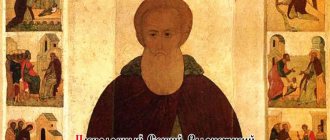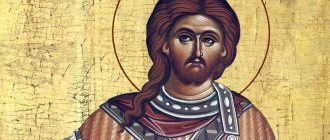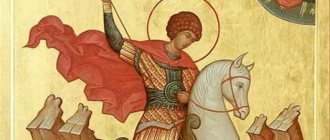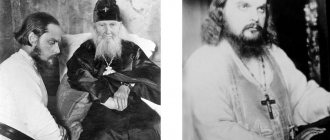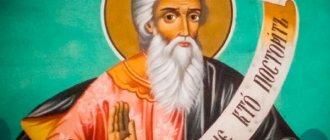| St. Euphrosyne of Suzdal. Icon |
Euphrosyne of Suzdal
(1212 - 1250), princess, reverend Memory on September 18 on the day of glorification, September 25, in the Cathedrals of the Bryansk and Vladimir saints
In the world, Theodulia, born in 1212, was the eldest daughter of the holy martyr Michael, Grand Duke of Chernigov. The blessed Prince Michael and his wife Feofania had no children for a long time and often visited the Kiev Pechersk monastery, where they prayed to the Lord to give them children. The blessed princess Euphrosyne was their first daughter, asked of the Lord in prayer. The Most Holy Theotokos, who appeared to them three times, informed them that their prayer had been heard and the Lord would give them a daughter.
Theodulia was brought up in deep faith and piety. The educated boyar Theodore (September 20) had a great influence on her upbringing. The princess's versatile education and rare beauty attracted many.
The princess was betrothed to the holy noble prince Theodore (+1233), brother of St. Alexander Nevsky, but her groom died on the very day of the wedding. The princess remained in the Suzdal convent in honor of the Order of the Robe of the Mother of God, where she soon took monastic vows with the name Euphrosyne, in honor of Euphrosyne of Alexandria.
The very young nun followed the rules of monastic life with amazing zeal, noticeably surpassing the other nuns of the monastery in firmness of mind, spiritual maturity and extreme abstinence. The Lord Himself visited the ascetic, commanding her to stay awake and strengthen herself in her feat. Until the end of her earthly life, St. Euphrosyne observed the instructions of the Savior, overcoming countless insidious temptations. They soon learned about the rare ascetic life of the Monk Euphrosyne in Suzdal and beyond. Many people visited the monastery to hear the teachings of St. Euphrosyne about love, prayer, obedience and humility. Often after such conversations, many accepted the monastic image and began more zealous service to God. The abbess of the monastery herself resorted to the advice of the saint. At the request of the ascetic, the sisters of the monastery were divided into two halves: nuns-virgins and nuns-widows. This contributed to the spiritual growth and consolidation of the purity of the sisters of the monastery. Euphrosyne did not hold a leadership position in the monastery [1], but with her life and exploits she elevated its significance so much that the monastery became the best convent in Rus'.
| Cancer with the relics of St. Euphrosyne of Suzdal. Photo by S.M. Prokudin-Gorsky. Beginning XX century |
In a special revelation, the Lord predicted to the blessed abbess the martyrdom of her own father, as well as the invasion of the Mongol-Tatars into Rus'.
In 1238, countless hordes actually attacked the Russian state. Destroying everything in their path, they approached Suzdal. The city was completely destroyed and burned by them, and only the monastery of St. Euphrosyne survived through her prayers. The saint reposed before God on September 25, 1250.
Relics and veneration
At the tomb of the saint, believers have long received grace-filled help in healing various ailments. The glorification of the saint initially took place under Metropolitan Anthony of Moscow and All Rus' and Tsar Ivan the Terrible [2]. Then, on September 18, 1698, the glorification of the Venerable Euphrosyne, with the blessing of Patriarch Adrian, was performed by Metropolitan Hilarion of Suzdal. In the same year, the relics of the saint, buried in hiding, were found. From that time on, they became the main shrine of the cathedral church of the Deposition of the Robe Monastery, where they rested for more than three hundred years (not counting the short period when they were in the Lazarus Church).
In 1919, by order of the Presidium of the Suzdal Executive Committee, the relics were opened, and in 1922, during the confiscation of church valuables, they were requisitioned and entered into the anti-religious exhibition of the Suzdal Museum. On November 16, 1988, when the Millennium of the Baptism of Rus' was celebrated, they were transferred to the only church then operating in Suzdal - Tsarekonstantinovskaya. A few years later, the relics of the famous Suzdal saint ended up in the hands of the so-called schismatics. "Russian Orthodox Autonomous Church" (ROAC).
At the beginning of the 21st century, in the Suzdal Robe Convent there was only a particle of the saint’s relics. The Vladimir diocese has repeatedly stated that it considers it illegal for schismatics to keep the shrine. After many years of proceedings, at the end of March 2015, the shrine - as “state property” - was seized from the ROAC and transferred to the Vladimir administration of the Federal Property Management Agency, which soon transferred the relics for the use of the Vladimir diocese of the canonical Church. Metropolitan Evlogii (Smirnov) of Vladimir transferred the venerable remains into a special shrine, after which the relics were placed in the Deposition of Robe Cathedral of the monastery, where they were kept until the revolution. The return of the shrine was marked by a solemn bishop's Divine Liturgy in the monastery cathedral on April 14 of that year [3].
Venerable Euphrosyne (in the world Theodulia) of Suzdal, princess
Brief life of the Venerable Euphrosyne (in the world of Theodulia) of Suzdal
Venerable Euphrosyne, Princess of Suzdal, was born in 1212.
In Holy Baptism she bore the name Theodulia and was the eldest daughter of the holy martyr Michael, Grand Duke of Chernigov (September 20). The blessed Prince Michael and his wife Feofania had no children for a long time and often visited the Kiev-Pechersk monastery, where they prayed to the Lord to give them children. The blessed princess Euphrosyne was their first daughter, asked from the Lord in prayer. The Most Holy Theotokos, who appeared to them three times, informed them that their prayer had been heard and the Lord would give them a daughter. Theodulia was brought up in deep faith and piety. The educated boyar Theodore (September 20) had a great influence on her upbringing. The princess's versatile education and rare beauty attracted many.
The princess was betrothed to the holy noble prince Theodore († 1233; commemorated June 5), brother of St. Alexander Nevsky, but her groom died on the very day of the wedding. The princess remained in the Suzdal convent in honor of the Placing of the Robe of the Mother of God, where she soon took monastic vows with the name Euphrosyne in honor of Euphrosyne of Alexandria.
The very young nun followed the rules of monastic life with amazing zeal, noticeably surpassing the other nuns of the monastery in firmness of mind, spiritual maturity and extreme abstinence. The Lord Himself visited the ascetic, commanding her to stay awake and strengthen herself in her feat. Until the end of her earthly life, St. Euphrosyne observed the instructions of the Savior, overcoming countless insidious temptations. They soon learned about the rare ascetic life of the Monk Euphrosyne in Suzdal and beyond. Many people visited the monastery to hear the teachings of St. Euphrosyne about love, prayer, obedience and humility. Often after such conversations, many accepted the monastic image and began more zealous service to God. The abbess of the monastery herself resorted to the advice of the saint. At the request of the ascetic, the sisters of the monastery were divided into two halves: nuns-virgins and nuns-widows. This contributed to the spiritual growth and consolidation of the purity of the sisters of the monastery. After the death of the abbess, the Monk Euphrosyne took over as abbot.
In a special revelation, the Lord predicted to the blessed abbess the martyrdom of her own father, as well as the invasion of the Tatars into Rus'. In 1238, countless hordes of Tatar-Mongols actually attacked the Russian state. Destroying everything in their path, they approached Suzdal. The city was completely destroyed and burned by them, and only the monastery of St. Euphrosyne survived through her prayers.
The saint reposed before God on September 25, 1250. At her tomb, believers continued to receive grace-filled help in healing various ailments. On September 18, 1698, with the blessing of Patriarch Adrian, Metropolitan Hilarion of Suzdal glorified the Venerable Euphrosyne.
The complete life of St. Euphrosyne (in the world of Theodulia) of Suzdal
The Monk Euphrosyne was born in 1212 and was the eldest daughter of the holy martyr Michael, Grand Duke of Chernigov. The blessed Prince Michael and his wife Feofania did not have children for a long time and often visited the Kiev Pechersk monastery, where they prayed to God to give them children. The Most Holy Theotokos appeared to them three times and said that their prayer had been heard - they would have a daughter, who should be named Theodulia - she would be a minister of the Blachernae Church.
The time had come for the birth of a daughter and they named her, according to the word of the Mother of God, Theodulia (servant of God). The newborn was baptized in the Kiev-Pechersk monastery, and the abbot himself became her successor.
She had four brothers and a sister Maria (the wife of Prince Vasily of Rostov, tortured by the Tatars (1238, March 4 (17)).
The parents looked at Theodulia with surprise and awe. If her nurse ate meat, then Theodulia, while still in diapers, refused to take the nurse’s breast all day. One day a mother had a vision: she was flying to the sky on wings and giving her daughter to God.
Theodulia grew up, and the blessed Prince Mikhail himself began to teach her the Holy Scriptures “from books and other wisdom.” Otherwise, the young princess’s mentor was the boyar Theodore, distinguished for his wisdom and learning. The life notes Theodulia’s education, deep knowledge of ancient literature: “She knew all the books of Virgil and Vitius, she was knowledgeable in the books of the Askilops and Galenians, the Aristotelians and the Omirovs and Platonov...” This list includes the philosophers Plato and Aristotle, the poets Homer and Virgil, the doctors Aesculapius and Galen. Theodulia was brought up in deep faith and piety, surpassing her peers in beauty and success in learning.
In her youth, she saw in a dream the Last Judgment: a sea of fire and heavenly abodes. The Most Holy Theotokos called on her to share the bliss of the righteous, and the Lord held the Book of Life in His right hand. In another vision, she was shown the Kiev-Pechersk Monastery and its monks glorifying the Lord. At the same time, the abbess of the Suzdal monastery had a revelation that a young virgin should come to her and need to be accepted into the monastery.
In 1233, Theodulia was betrothed to the holy noble prince Theodore Yaroslavich (1233; commemorated June 5 (18), the brother of St. Alexander Nevsky. The parents agreed, and Theodulia submitted to her parents’ will, but secretly prayed to the Mother of God for the preservation of her virginity, since she felt a calling to monastic life. And again the Blessed Virgin, in a dream vision, commanded to obey your parents, saying: “Defilement will not touch your body.”
Feodulia went to Suzdal for the wedding, but the marriage did not take place. When the guests had already gathered for the feast, the groom unexpectedly died, as the chronicle tells about it: “Prince Theodore Yaroslavich the Great passed away... And he was still young. And who would not favor this? The wedding has been arranged, the wedding has been arranged, the bride has been brought in, and the princes have been called. And there will be joy in the place of crying and lamentation.”
Theodulia did not return home and begged the abbess of the monastery in honor of the Placement of the Robe of the Most Holy Theotokos in Blachernae to accept her. The abbess agreed, remembering the revelation that had happened to her, and on September 25, the day of the Venerable Euphrosyne of Alexandria, Theodulia was tonsured with the name Euphrosyne. The parents accepted this as the will of God and submitted.
The young nun zealously followed the rules of monastic life, surprising the sisters with her prudence, high spirituality and maturity of mind. Euphrosyne spent most of the day in prayer - in a temple or in a cell, and at night she studied the word of God. Sometimes she spent whole weeks without eating food - she only drank a little water. Soon after her tonsure, Euphrosyne was rewarded with the appearance of the Savior, who commanded her to stay awake and strengthen herself in feat.
The Lord allowed her to constantly fight with demons; Euphrosyne endured their attacks for a long time and prayed for her strength in this battle. The abbess told her: “Without the attack of the enemy, there would be no strong royal warriors, and the Lord allows those who love Him to endure temptations, so that their virtues may be revealed.”
Euphrosyne did not hold a leadership position in the monastery, but with her life and exploits she elevated its significance so much that the monastery became the best convent in Rus'. The sisters revered her and the abbess herself constantly sought advice. The venerable woman proposed dividing the monastery into two halves: the maiden half and the widow half. The city wives attended the church in the name of the Most Holy Trinity on half of the widows, and the girls attended the main monastery Church of the Deposition of the Robe, which was on the half of the virgins.
Here the Monk Euphrosyne read and sang in the choir. In addition, she was entrusted with interpreting the Holy Scriptures and speaking instructions to the sisters and city maidens.
They soon learned about the rare ascetic life of the saint not only in Suzdal, but also far beyond its borders. Many people visited the monastery to hear the teachings of St. Euphrosyne about love, prayer, obedience and humility. Often after such conversations those who came to the monastery to pray left the world.
When epidemics and pestilence began in Rus', the Mother of God appeared to the saint and promised the gift of healings, after which she began to treat not only the sisters in the monastery hospital, but also those who came to the monastery with serious illnesses. The maiden Taisiya, healed by her, took monastic vows in the monastery together with her mother.
The Monk Euphrosyne remained silent for some time, after which she received from God the gift of prophecy. She predicted the imminent death of the abbess who received her and the martyrdom of her father. Before the invasion of Batu, the Lord revealed to the ascetic that trouble was coming to Rus', that Suzdal would be devastated: “There will be a fierce visit in order to get rid of bitter eternal torment,” said the Lord, “...I promise you and those living here that the sign of the cross will protect your monastery " Then the monk saw two Angels with bows drawn in their hands, guarding the monastery. They told the saint that the nuns who would seek salvation outside the walls of the monastery would either return to it or suffer.
In 1238, Batu's troops devastated Suzdal. The Monk Euphrosyne and her sisters prayed day and night for the salvation of the monastery, and the monastery survived. The enemies were unable to approach the monastery. Tradition says that Batu, having learned about this, tried to see the monastery from the hill, but it hid from him.
When his father went to the Horde, where martyrdom awaited him, Euphrosyne, in a letter to him, urged him to stand firmly for the faith so that he “... would not bend to the will of the Tsarev” and advised him to obey the boyar Theodore, whom she called “a philosopher among philosophers.” After the execution of her father and boyar Theodore on September 20, 1246, both of them appeared before her, told about their martyrdom and thanked her for strengthening and prayerful help in the hour of death.
After her father's death, she dressed in rags and spent many days in fasting and prayer. When one of the residents of Suzdal was shocked to see her shabby clothes, Euphrosyne said: “Fish in the cold, covered with snow, does not spoil or stink, and even becomes tasty. So we, monks, if we endure the cold, we become stronger and will be pleasing to Christ in an imperishable life.” The same man asked for guidance; she answered him: “Listen, lover of Christ! Happy is the house in which the gentlemen are pious, happy is the ship that is steered by a skillful helmsman, blessed is the monastery in which abstemious monks live. But woe to the house in which wicked masters dwell; woe to the ship that does not have a skilled helmsman; woe to the monastery in which there is no abstinence; the house will become impoverished, the ship will be wrecked, and the monastery will be empty. You, God-loving man, give alms, first of all to your household servants, and if you want to give from your generosity to us in the monastery, then send only wooden oil, candles and incense. This is enough for us!” That man, previously callous, completely changed and became merciful.
After the death of the abbess, the Monk Euphrosyne continued the spiritual leadership of the monastery, maintaining strict order in it. Her entire future life was a feat of complete self-denial, the strictest fulfillment of monastic vows. Already during her lifetime, people considered her righteous for her maternal responsiveness and gifts of grace.
Shortly before the death of the saint, the earthquake she predicted occurred in Suzdal, during which she saw the Most Holy Theotokos in the sky, begging together with the saints of the Son of God for the salvation of the city and the people in it. After this event, her father and boyar Theodore appeared to her, informing her of her imminent death. The venerable woman began to prepare. She was ill for a short time. Having received the Holy Mysteries of Christ, she said: “Glory to Thee, Most Holy Trinity! Our hope, Most Holy Theotokos, help me! Lord, into Your hands I commend my spirit!”, she crossed herself and passed into eternal life on September 25, 1250. Seventeen years ago on the same day she took monastic vows.
At her grave, the faithful began to receive gracious help, and with the blessing of Patriarch Adrian, the glorification of the saint took place on September 18, 1698. Her incorrupt relics rested in the cathedral church of the Deposition of the Robe Monastery.
The entire life of the Monk Euphrosyne - both external and internal - was full of trials: the death of her fiancé, father, brother, mentor. The great devastation of the Fatherland and the incessant spiritual warfare required patience, meekness and courage. Venerable Euphrosyne is a Russian patient. Her image is the embodiment of the patience of Russian women. Without him, the Russian people and state could not have withstood the trials that befell them from century to century. To bear the disorders of life, transforming them through prayer and labor - this feat was accomplished and bequeathed by the Monk Euphrosyne to Russian women.
The saint's help is especially effective in healing those possessed by evil spirits. Just as during her life she waged a constant battle with demons and defeated them with prayer and humility, so after her death Euphrosyne of Suzdal helps drive away demons and free a person from the evil force that torments his soul and body.
The name of the saint before her tonsure - Theodulia - “Servant of God” speaks of her purpose. The monastic name - Euphrosyne - reveals a special gift of spiritual joy during the endurance of earthly sorrows: the Monk Euphrosyne teaches the transformation of the sorrow of the world into the joy of unity with God through venerable feat through patience.
In none of the ancient lives of the holy women of Rus' are there as many references to the gracious help of the Mother of God as in the life of the Venerable Euphrosyne of Suzdal. The Most Pure One herself indicated to Theodulia’s parents the name of her daughter and uttered the mysterious words: “she will be a servant of the Blachernae Church.” She blessed Theodulia to become a monk and sent her to a monastery dedicated to the Position of the Robe of the Mother of God in Blachernae. The Monk Euphrosyne received many gifts of grace from the Mother of God. Then the meaning of the words of the Mother of God about the service of the Venerable Euphrosyne, who from birth to the last moment of her life was a servant of the Mother of God, becomes clear.
See also: “ The Life of the Venerable Euphrosyne of Suzdal” as presented by St. Demetrius of Rostov.
Prayers
Troparion, tone 4
Your holy memory rejoices the Suzdal country, / and calls all the faithful to your all-honorable temple, / where now your all-glorious memory is celebrated, Venerable Euphrosyne: / pray to Christ God / for our souls to be saved.
Kontakion, tone 2
A pure vessel of virginity filled with oil of prayer and love, / you kindled an unquenchable lamp in your heart, O venerable one, / with it you went forth cheerfully to meet the Heavenly Bridegroom, / you were received into His bright palace, / where you now join the faces of angels and saints, / pray, we pray, to Christ God, / to deliver us from some of the foolish virgins.
Kontakion, tone 6
My Sweetest Bridegroom, / The beautiful Euphrosyne cried out to Christ, / for the sweetness of Thy love fills my soul with hope / and the beauty of Thy mercy delights my heart, / to labor together in suffering for You, having hope in You, / that I may be worthy of the palace with the wise virgins / and rejoice at We will give you communion. / Moreover, reverend one, in reverence for the feat of your labors, we pray to you: / pray that the door of the palace will not be seen by us.
Kontakion, tone 8
You made virginity possible through purity, / and you enlightened your spiritual purity, / through fasting and vigil, you enslaved the flesh to the spirit, / and, Venerable Euphrosyne, / honoring the feats of your labors, we pray: / pray to Christ God for the salvation of our souls.
When is Euphrosyne of Suzdal Memorial Day in 2022?
The Day of Remembrance of the Venerable Euphrosyne of Suzdal will be celebrated twice in 2022.
- October 1
– Glorification of Euphrosyne of Suzdal. - October 8
is the day of the death of Saint Euphrosyne.
According to the old style, the day of memory of Euphrosyne of Suzdal was celebrated on the church calendar on September 18. The day of the death of St. Euphrosyne is celebrated on the church calendar according to the old style - September 26. The dates are not moving; they are celebrated by the Orthodox Church on the same day every year.
Biography
Her parents were the holy martyr Prince Mikhail Vsevolodovich of Chernigov, and her mother was the daughter of Roman Mstislavich Galitsky, whose name has not reached us. According to the life[1], Euphrosyne was the first begged child, before whose birth the couple prayed earnestly. Boyar Theodore, who was later martyred along with the prince in the Horde, influenced her education.
She mastered literacy at the age of 9. The Life reports that Alexander Nevsky's brother Fyodor Yaroslavich was chosen as a groom for the princess, but he died unexpectedly at the age of thirteen in Novgorod on June 5, 1233.
The princess remained in the Suzdal convent, where she soon took monastic vows with the name “Euphrosyne” (in honor of Saint Euphrosyne of Alexandria). Over time, she became his abbess.
On the initiative of the saint, the Trinity Monastery was founded in Suzdal for the tonsure of “married wives.”
The year of Eurofsinia’s death is not indicated in the Life; the date found in the literature - 1250 - is a guess.
The Life reports that the saint was buried on September 27 in the Deposition of Robe monastery, mourned by the clergy and all the people.

